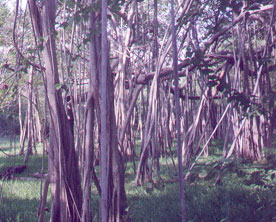Banyan
Botanical Name: Ficus bengalensis Sanskrit name: Nyagrodha, Kalpavriksha
English Name: Banyan Hindi name: Vad
The banyan tree is well known all over India. The tree has what is known as the “aerial roots” its branches drop to the ground, take roots again, and send out more twisting and trailing branches, thus extending the growth of the
tree indefinitely. The Banyan is sacred to Hindus and Buddhists.
The name Banyan tree in English seems to have been given by Europeans in the Persian Gulf to a particular tree of this species under which Banias or members of the Indian merchant class used to congregate for worship and business.
Nyagrodha symbolizes Shiva and is, therefore, held sacred. Worshiped on Hindu Festival “Vad-Savitri Day” the tree is also the symbol of Lord Bramha.
 Nyagrodha tree in Hindu mythology is called Kalpavriksha or the wish fulfilling tree, a tree that gives to the worshiper, food and drink, clothes and ornaments, gift of children and even beautiful maidens. The anthromorphic
worship of the tree is represented in a Buddhist sculpture from Besnagar.
Nyagrodha tree in Hindu mythology is called Kalpavriksha or the wish fulfilling tree, a tree that gives to the worshiper, food and drink, clothes and ornaments, gift of children and even beautiful maidens. The anthromorphic
worship of the tree is represented in a Buddhist sculpture from Besnagar.
The Pradhan tribes worship the tree because of the following reason. When Jalrandha, the guru of the Pradhan tribe died, his body was buried by his son under Palas (Flame of the forest) tree. The sons used to daily light a fire
on the grave to keep away the animals from desecrating the grave. One day they found a Nyagrodha tree growing out of the grave. That night the eldest son of the guru had a dream in which his father asked him to look after the tree as it had grown out of their
father’s bones and brains. Pradhans consider the hanging roots of the tree as the matted, long hair of the guru.
In Vishnu Purana, the tree is compared to Vishnu ; “As the wide spreading Nyagrodha tree is compressed in a small seed, so at the time of dissolution, the whole universe is compressed in thee as its germ. As the Nyagrodha germinates from the seed and becomes
first a shoot and then rises into loftiness, so the created world proceeds from thee and expands into magnitude.”
It occurs throughout the forest tracts of India, from the sub-himalayan region to the deciduous forests of Deccan and south India. It yields fodder, medicine, rope and timber and is useful in afforestation of dry areas.
Various parts of Banyan have medicinal properties. The latex is applied externally to bruises, and in rheumatism, lumbago and toothache. The leaves are applied as a poultice to abscesses. The bark is astringent, used in dysentery,
diarrhoea and diabetes.
_______________________________________________________________________
Importance of Indigenous plants in Indian Mythology and folklore—Compiled by Ms. Priti Sawant
Photograph of banyan roots by Susan Sharma